|
Pompeii
A Remarkable Roman City Frozen in Time
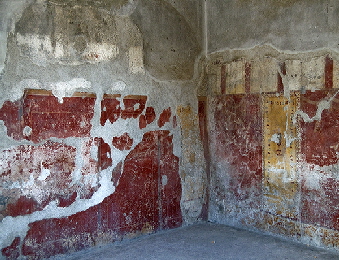 I first visited Pompeii with my parents in December of 1976. We took a self-guided day-long tour of this unique city, and its history and architecture made such an impression on me that I promised someday
I would return. That next opportunity was not until 35 years later and it was worth the wait. I first visited Pompeii with my parents in December of 1976. We took a self-guided day-long tour of this unique city, and its history and architecture made such an impression on me that I promised someday
I would return. That next opportunity was not until 35 years later and it was worth the wait.
Pompeii had 20,000 inhabitants when Mt
Vesuvius erupted. In 19 hours, the eruption's massive heat wave killed thousands and buried the city and nearby Herculaneum under 75 feet of ash for over
1,700 years. Of Pompeii's inhabitants, half were children. The average Pompeian woman was 4 1/2 feet tall and lived to the
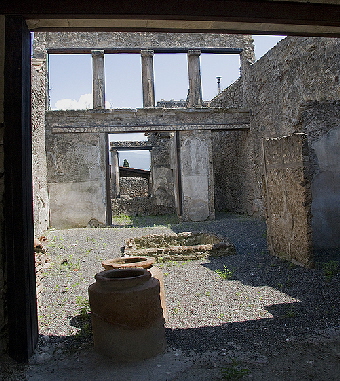 age of 39. The average man was a few inches taller and could expect to live to the age of 41. age of 39. The average man was a few inches taller and could expect to live to the age of 41.
Pompeii was a holiday town for many
wealthy Romans, who poured their money into making their villas the most decorated. Beautiful frescoes, many of them still showing the bright colors and scenic
details, adorned the walls, and intricate mosaic floor designs indicated an individual's stature in the community. Homes included elegant courtyard gardens
and an abundance of modern conveniences. Each room was heated by hot air running through cavity walls and spaces under the floors, while sophisticated hydraulic pumps
provided running water. In Roman times, sex was not taboo and guides enjoy pointing at the numerous phallic symbols (a sign of fertility and success) carved on
street corners and the entrances to homes.
 |
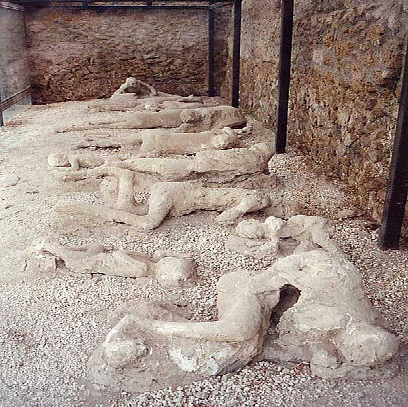 As is typical of Roman times, the entire city had an excellent system for the control and distribution of water. From a great reservoir, water flowed
invisibly through underground pipelines into drainage systems. But even more interesting, the designs did much more than distribute the waters. In the case of extreme drought, the
water supply would first fail to reach the public baths (the least vital service), then private houses and businesses, and only in extreme drought the system would fail to supply the public fountains (the most vital service
). Talk about forward-thinking in water conservation. As is typical of Roman times, the entire city had an excellent system for the control and distribution of water. From a great reservoir, water flowed
invisibly through underground pipelines into drainage systems. But even more interesting, the designs did much more than distribute the waters. In the case of extreme drought, the
water supply would first fail to reach the public baths (the least vital service), then private houses and businesses, and only in extreme drought the system would fail to supply the public fountains (the most vital service
). Talk about forward-thinking in water conservation.
What makes this town so unique is that when it was excavated, it
provided the most authentic image of how Roman life was in 86 AD. It is the only ancient
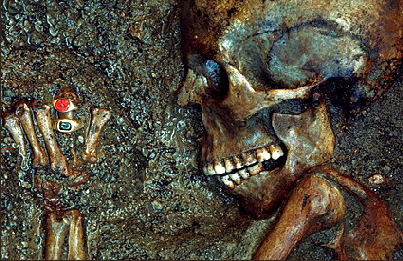 town of which the whole
topographic structure is known precisely as it was, with no later modifications or additions. It was not distributed on a regular plan as we are used to seeing in
Roman towns, due to the difficult terrain. But its streets are straight and laid out in a grid, in the purest Roman tradition; they are laid with polygonal stones,
and have houses and shops on both sides of the street. town of which the whole
topographic structure is known precisely as it was, with no later modifications or additions. It was not distributed on a regular plan as we are used to seeing in
Roman towns, due to the difficult terrain. But its streets are straight and laid out in a grid, in the purest Roman tradition; they are laid with polygonal stones,
and have houses and shops on both sides of the street.
One of the most fascinating discoveries that I remember from
my first visit was learning about the large number of holes found in the volcanic deposits that
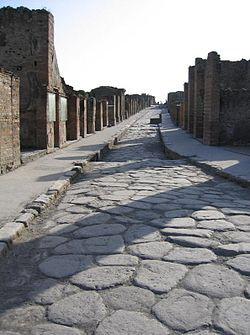 represented corpses of people and animals buried and preserved by the ash. Early in the excavation it was discovered that filling these molds
with plaster produced detailed casts of the victims, including their facial expressions. In 1976, I remember walking through the city and encountering some of the
plaster statues (or replicas) which had been placed in the very same spot they were originally found. That was definitely a moment in time. Nowadays, archaeologists
use a resin to form casts, which lasts longer and helps to preserve the bones for further study. represented corpses of people and animals buried and preserved by the ash. Early in the excavation it was discovered that filling these molds
with plaster produced detailed casts of the victims, including their facial expressions. In 1976, I remember walking through the city and encountering some of the
plaster statues (or replicas) which had been placed in the very same spot they were originally found. That was definitely a moment in time. Nowadays, archaeologists
use a resin to form casts, which lasts longer and helps to preserve the bones for further study.
In the winter of 1976 there were fewer visitors walking
through the streets of Pompeii than during my most recent visit in the early summer of 2011 as part of a shore excursion during a Mediterranean cruise. Our
guided tour included the amphitheatre, the forum (main marketplace), several well-preserved homes, and of course the brothel and its unique wall frescoes to set
the mood. I was able to appreciate a lot more 35 years ago since we were then not on a timeline, being rushed through various parts of the city. But this trip served to
reinforce what a significant place this is and it makes me want to return yet again to explore it on my own, at leisure.
More than 2.5 million visitors come to Pompeii each year, and in order to preserve some of the more unique structures, only about a third of the city is now open. That may be why I
remember walking through much more of the city 35 years ago. No matter, each visit continues to reveal new and interesting bits of history.
|